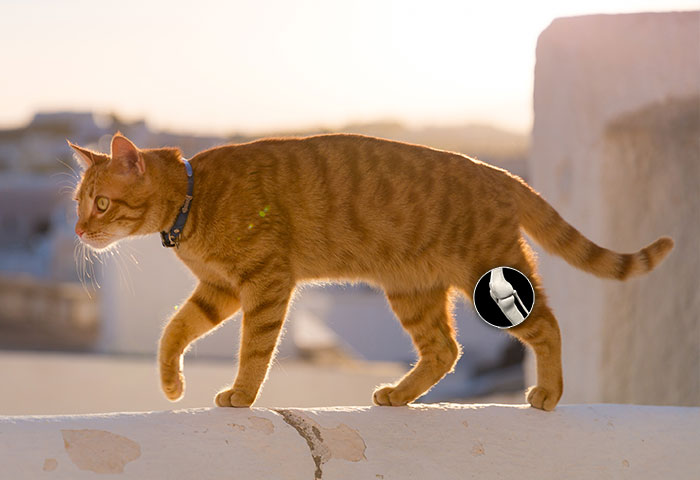


SERVICES
Feline Hind Limb/Knee Injuries

In cats, lameness that stems from the stifle (knee) joint tends to be associated with an ACL injury or, less commonly, Luxating Patella. Additionally, hind limb lameness can be due to bone fractures or issues with the hip or other areas of the leg. With any of these conditions, it is important to remember that early intervention will provide for the most ideal overall prognosis. When a pet is lame, they are in pain. When the lameness and pain is allowed to continue, the inflammation present causes irreversible damage to the joint. Surgery to fix the underlying problem will not address the arthritis that has already built up in the joint, only slow down future progression.
Click on the procedure below to learn more.
Cruciate Ligament (ACL) Injuries
Injuries to the anterior cruciate ligament (ACL) in the knee can lead to severe debilitating lameness and pain. Early diagnosis and treatment will produce the best results and limit the severity of arthritis. Many ACL injuries start out as partial tears with mild intermittent lameness. Even partial ligament injuries can lead to severe irreversible changes in the joint and should therefore be treated proactively.
To stabilize the joint, we offer surgical stabilization. With this procedure the first part of the operation is to explore the joint, remove the remnants of the torn ligament, and to assess the meniscus which acts as a shock absorber between the two major bones that make up the knee joint. The second part of the surgery is to stabilize the joint and eliminate the abnormal front to back movement and instability in the joint that occurs when the ACL tears.
Extra-Articular Stabilization - Involves placing synthetic suture material on the outside of the joint to mimic the action and direction of the original ligament. The pet no longer has an ACL and the suture material stabilizes the knee. This procedure is the most common repair done in cats.
Luxating Patella
Luxation of the patella (knee cap) is a relatively common problem in dogs, but can also occur in cats. Luxation means that the patella is able to move out of place from the trochlear groove of the knee. The severity of the luxation varies from patient to patient, but in all patients that abnormal movement of the patella causes degenerative changes in the joint over time. Some patients can be managed on anti-inflammatory pain medications, but the joint changes that continue to occur are irreversible.
Due to the progressive nature of the degenerative joint changes (arthritis), we recommend prompt surgical correction in patients with patella luxation. With this condition, there is no one procedure that applies to all patients. Initially, we enter the joint on an exploratory basis with the objective of identifying the specific factors that are causing the luxation. Some patients have trochlear grooves that are too shallow to “trap” the patella from sideways motion, some have a mal-alignment of the patellar tendon causing a "pull" on the patella in a particular direction and many patients have both. A surgical plan is made intra-op once we have determined what that particular pet requires.
As with any surgical procedure, overall prognosis is dependent upon the amount of degenerative changes already present in the joint. While every pet will benefit from having the luxation surgically corrected, those that address it early will have the most ideal end result.
Fracture Repair
At Packerland Veterinary Center, we are able to handle the simplest of broken bones, all the way through the most complex of fracture presentations. Dr. Dunbar's extensive training and orthopedic experience have given him the tools to provide the best care possible for fractures of all shapes and sizes.
There is no cookie cutter method to approach every patient with a broken bone. We have to be flexible in the methods that we have available to approach each individual situation. Some fractures may heal adequately with external support such as casting, while others require elaborate bone plate and screw repairs along with bone grafting techniques. The trick is to know what works with each fracture presentation, and to be able to perform the procedure in a manner that will give the patient the best recovery possible.
Stem Cell Therapy (SCT)
This procedure involves surgically harvesting fat tissue from your pet and then processing that tissue in house to remove the stem cells. The stem cells are then “activated” with our special equipment and later the same day we can inject the cells back into specific areas of the patient where needed. Stem Cells will not change any structural issues that have lead to any current knee problems (excessive tibial slope, shallow trochlear groove, etc), but can help with the arthritis that has formed in the joint by helping to reduce inflammation and rebuild the joint cartilage surface, making the pet more comfortable overall. In the case of knee issues, SCT is often used in conjunction with surgical treatment to maximize overall results.
For more in-depth information about Stem Cell Therapy, click here.
Platelet Rich Plasma Treatment (PRP)
Popular in human orthopedics, PRP therapy utilizes a patient's own blood plasma as an all-natural, drug free pain relief option. Once activated by our specialized equipment, the PRP works to initiate and accelerate tissue repair and reduce localized inflammation. PRP can be utilized in a variety of conditions, but most often is used to treat the inflammation present in injured joints and tendons. While it does not provide a more long-term regeneration of cells like Stem Cell Therapy, PRP can be an affordable short term solution to treat pain and inflammation in our patients.
PRP treatment begins with a blood draw from the patient. The blood is then specially processed to bring out the PRP mix of concentrated serum and platelets. Patients then receive light sedation while the PRP is injected into the specific area or areas needing treatment. Any additional PRP can be frozen and saved short-term for future treatments that may be needed in the months following. While each pet's response to PRP is different, we have seen great short and longer term results utilizing this therapy.



